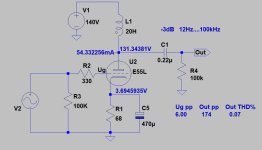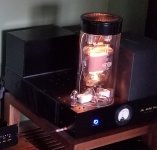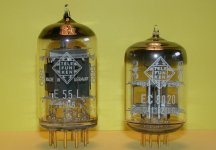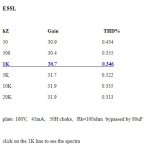I cannot see the curves from your link (if you can help with that it would be much appreciated), but I am aware that 6E5P has mu = 30 and low Ra ~ 980 ohm...with 4-5:1 step own transformer Rout = ~217 ohm or so., mu= ~4.7. So, pretty much perfick to drive Slagle AVC. No?Andy, totally agree, a amplifier is always a composition and all parts must work together
A friend use this driver tube for a PX4
Its the russian 6E5P, a lot of gain very low distortion, a perfect linearity and a good overload margin and a very low anode resistance perfect for your IT
look at these curves
6Э5П / 6E5P [triode] | VT52.com
These tubes are dirt cheap on Ebay
Best, Robert
Oh yes use these on my speaker XO grainless & transparent but now getting very expensive. LolI use this resistors, very good
Powertron FPR2-T218 30W Metal Foil Resistor | HIFICollective
The impedance step down will be the square of the voltage stepdown, so 50 Ohms not 217 Ohms.I cannot see the curves from your link (if you can help with that it would be much appreciated), but I am aware that 6E5P has mu = 30 and low Ra ~ 980 ohm...with 4-5:1 step own transformer Rout = ~217 ohm or so., mu= ~4.7. So, pretty much perfick to drive Slagle AVC. No?
Best, Robert
Interesting site with the simulation. The 10(Y) seems to win hands down in linearity . . .Using Trioda's load line calculator (Triode / Pentode Loadline Simulator v.1.0 (20161216 www.trioda.com)) I am playing around with different Rk values. Which parameters should be optimized? For example: lowest value h2 (Harmonic Distortion) or lowest value Ug or Other?
I looked at some other tubes I have. The 12BH7. What surprises me is the non-linearity, that is, it almost looks like a remote cut-off tube. In one of my builds, when I use it it instead of an ECC82 [which normally is seen as lineair] it is very 'warm/dark'. But the ECC82 is also non-lineair here.
It looks that due to the model just a transformer coupling is possible?
My 10Y data (long plate version): I had Vb 390V; Rk = 1200Ω; Vk = -35 V or so; Ik = 30 mA. Ck = several 10µ and 15 µF mylar. Input 6SJ7 at 47K Rload; Vg2=90 to 100V. I It gave a stable 1-2% 2ndH (the only one I see with my analog distortion meter).
I used 7.5V AC (best sounding) and DC (dull) even though I had designed a Gyrator/CC schema; but looking back, I shunted the output of that with a capacitor. And the real guru's later taught me: no no, keep the high impedance load of the filament.
I had a 5KΩ transformer (with the long plate this works), but I used I think the 4Ω tap . . . (never had the documentation; I gave the transformer away so can't recall). I used this for about 8 years. [Then I changed to another speaker than the 103Sigma, the most stupid move I made : even though my Quad 57 was superior, the 300B amplifiers were not ...]
Hi,
E55L Mullard or Telefunken NOS pairs are in US$700+ territory now. I've never tried them... have you? If so, what was your Operating Point?...the Va-k, Ia, Vg, and Ra? And, did you use an anode choke or an interstage transformer? At those NOS prices, new production EML 20A, 20B and 30A, some requiring input step up transformers perhaps, become competitive, especially if one would like to have a directly heated triode driver (and low Ra).
Best, Robert
E55L Mullard or Telefunken NOS pairs are in US$700+ territory now. I've never tried them... have you? If so, what was your Operating Point?...the Va-k, Ia, Vg, and Ra? And, did you use an anode choke or an interstage transformer? At those NOS prices, new production EML 20A, 20B and 30A, some requiring input step up transformers perhaps, become competitive, especially if one would like to have a directly heated triode driver (and low Ra).
Best, Robert
I'm going from memory: 130-150V at the anode, 30-35mA, 100 ohm resistor bypassed by 800-1000uF. Pentode connected to triode and loaded with 40-60H anode load. On Ebay, E55L tubes can still be found around 100 euros each, and even less. All E55L tubes (also marked 8233 made in the USA) all come out of the Mullard factories and all have the same indelibly expressed acid code at the base. Rca, Amperex, Telefunken on the glass are all re-branded tubes. Only the EC8020 tubes, all of them, were made by Telefunken. No E55L TFK then ...
Attachments
Trioded E55L output impedance only 600R, so even 20H choke is "enough" (40-60H is better, but 50..80mA capable is pricey).
I used it in spud amplifier at 20H primary inductance OPT with satisfaction.
If you use this tube as driver hotter (over 50mA anode current, at about 130V Vak), the distortion will be marginal.
Sample simulation.

The insensitivity requires gain (about 3x) stage, VAS or 1:4 SUT.
I used it in spud amplifier at 20H primary inductance OPT with satisfaction.
If you use this tube as driver hotter (over 50mA anode current, at about 130V Vak), the distortion will be marginal.
Sample simulation.

The insensitivity requires gain (about 3x) stage, VAS or 1:4 SUT.
Translation problems. I can't quite understand this part: can you be clearer and more detailed?The insensitivity requires gain (about 3x) stage, VAS or 1:4 SUT.
Thanks
As you can see, the driver gain not too much, it's requires -at least- 6Vpp input for driving -for example- 300B (-75V bias + headroom).
If you want to use it correctly (1.5 ..2 V RMS input for maximum power), another voltage amplifier stage (VAS) or stepup transformer (SUT) needed, with -at least- triple (3x) gain.
If you want to use it correctly (1.5 ..2 V RMS input for maximum power), another voltage amplifier stage (VAS) or stepup transformer (SUT) needed, with -at least- triple (3x) gain.
The mu (gain) of the E55L is 30.
Perhaps for 45 and 2A3 it would be fine on its own.
Would a Lundahl LL7902 or LL7903 transformer (wired 1:4) be OK to drive the 300B?
I am not an expert and would like to learn my calculations better. What formula did you use to derive these figures :
- required at least 6Vpp input to fully drive the 300B (-75V bias + headroom) ?
Thanks for your answers.
Perhaps for 45 and 2A3 it would be fine on its own.
Would a Lundahl LL7902 or LL7903 transformer (wired 1:4) be OK to drive the 300B?
I am not an expert and would like to learn my calculations better. What formula did you use to derive these figures :
- required at least 6Vpp input to fully drive the 300B (-75V bias + headroom) ?
Thanks for your answers.
At -75V bias the A1 limit requiring 150Vpp grid swing.
The simulated 174Vpp -at 6Vpp input- represents only 1.29dB headroom ... not too much, but usually enough.
I prefer higher (for example 2-3dB) headroom in driver stage, because sudden overshoots doesn't generate rough distortion peeks.
The higher headroom requiring proper designing.
The operating point of the tube must be at about:
tube saturating (Vg=0) voltage (at desired current) + half of swing voltage + headroom/2;
B+ must be greater than operating point voltage + half of swing voltage (at R loaded version) + headroom/2;
B+ must be greater than operating point voltage + choke/OPT primary DC loss (at inductive loading version) + headroom/2;
B+ must be greater than operating point voltage + half of swing voltage + 30..40V headroom (at active load -CCS/gyrator- version).
"The mu (gain) of the E55L is 30." .. in theory, if you load it with infinity impedance. In practice it's about 29.
If the expected driver output is 75Vp, the input of the driver must be equal 75/29=2.59Vp.
With 2dB headroom, the requiring input about 2.91Vp.
At this input the driver distortion must be -more or less- equal (not significantly more) than at 2.59Vp input.
If you use 1:4 SUT (which have 3.6 ... 3.8 gain depending of the loading, because most of stepup transformer (especially Lundahls) requiring proper terminating to eliminate HF bump, the overall gain is 4*30 (in practice about 3.7*29), so at 2.12Vp (1.5V RMS) input the driver output will be more than enough to drive even -75V biased 300B.
Even 1:2 wired SUT may be appropriate (better HF bandwidth).
The simulated 174Vpp -at 6Vpp input- represents only 1.29dB headroom ... not too much, but usually enough.
I prefer higher (for example 2-3dB) headroom in driver stage, because sudden overshoots doesn't generate rough distortion peeks.
The higher headroom requiring proper designing.
The operating point of the tube must be at about:
tube saturating (Vg=0) voltage (at desired current) + half of swing voltage + headroom/2;
B+ must be greater than operating point voltage + half of swing voltage (at R loaded version) + headroom/2;
B+ must be greater than operating point voltage + choke/OPT primary DC loss (at inductive loading version) + headroom/2;
B+ must be greater than operating point voltage + half of swing voltage + 30..40V headroom (at active load -CCS/gyrator- version).
"The mu (gain) of the E55L is 30." .. in theory, if you load it with infinity impedance. In practice it's about 29.
If the expected driver output is 75Vp, the input of the driver must be equal 75/29=2.59Vp.
With 2dB headroom, the requiring input about 2.91Vp.
At this input the driver distortion must be -more or less- equal (not significantly more) than at 2.59Vp input.
If you use 1:4 SUT (which have 3.6 ... 3.8 gain depending of the loading, because most of stepup transformer (especially Lundahls) requiring proper terminating to eliminate HF bump, the overall gain is 4*30 (in practice about 3.7*29), so at 2.12Vp (1.5V RMS) input the driver output will be more than enough to drive even -75V biased 300B.
Even 1:2 wired SUT may be appropriate (better HF bandwidth).
Ho cercato in giro per casa tra i materiali abbandonati da anni e ho trovato un paio di Lundahl LL7902. Questi possono essere configurati 1:2 e 1:4. Sapete dirmi se posso usarle come SUT con 300B o altre valvole?Se si utilizza SUT 1:4 (che ha un guadagno di 3,6 ... 3,8 a seconda del carico, poiché la maggior parte dei trasformatori stepup (specialmente Lundahl) richiede una corretta terminazione per eliminare il bump HF, il guadagno complessivo è 4*30 (in pratica circa 3,7 *29), quindi a 2,12 Vp (1,5 V RMS) l'uscita del driver sarà più che sufficiente per pilotare anche 300B polarizzati a -75 V.
Anche il SUT cablato 1:2 può essere appropriato (migliore larghezza di banda HF).
In un amplificatore a 2 stadi con ingresso SUT non è necessario un preamplificatore: posso usare un TVC (transformer volume control Stevens & Billington TX-102) davanti al SUT per regolare il volume?
Attachments
I searched around the house among the materials abandoned for years and found a pair of Lundahl LL7902. These can be configured 1:2 and 1:4. Can you tell me if I can use them as SUTs with 300B or other valves?
In a 2-stage amplifier with SUT input a preamplifier is not necessary: can I use a TVC (transformer volume control Stevens & Billington TX-102) in front of the SUT to adjust the volume?
(I apologise to everyone for mistakenly inserting the text in Italian.)
In a 2-stage amplifier with SUT input a preamplifier is not necessary: can I use a TVC (transformer volume control Stevens & Billington TX-102) in front of the SUT to adjust the volume?
(I apologise to everyone for mistakenly inserting the text in Italian.)
TVC/AVC requires low source (few hundred Ohms) impedance, most of sources don't have this.
I use TX-102 with CCS loaded #26 tube.
1:2 or even 1:4 SUT can be used before VAS stage ... if the tube's Miller capacitance enough low.
LL7902 also measured at 600R source impedance, so with some SS source/preamp it's usable.
I use TX-102 with CCS loaded #26 tube.
1:2 or even 1:4 SUT can be used before VAS stage ... if the tube's Miller capacitance enough low.
LL7902 also measured at 600R source impedance, so with some SS source/preamp it's usable.
A MOS source follower + series resistor can be added to tube line stages to give a low impedance drive. The series-resistor can take different values to optimise with Lundahl transformers, to control peaking. A small value is advisable in all cases (and all ITs).
If designed and implemented well, these have very low distortion and sound transparent - and offer improvements in sound, when driving ITs or volume controls that expect low driving-impedance.
If designed and implemented well, these have very low distortion and sound transparent - and offer improvements in sound, when driving ITs or volume controls that expect low driving-impedance.
- Home
- Amplifiers
- Tubes / Valves
- 10Y (or other DHT) replacing a C3G driver



